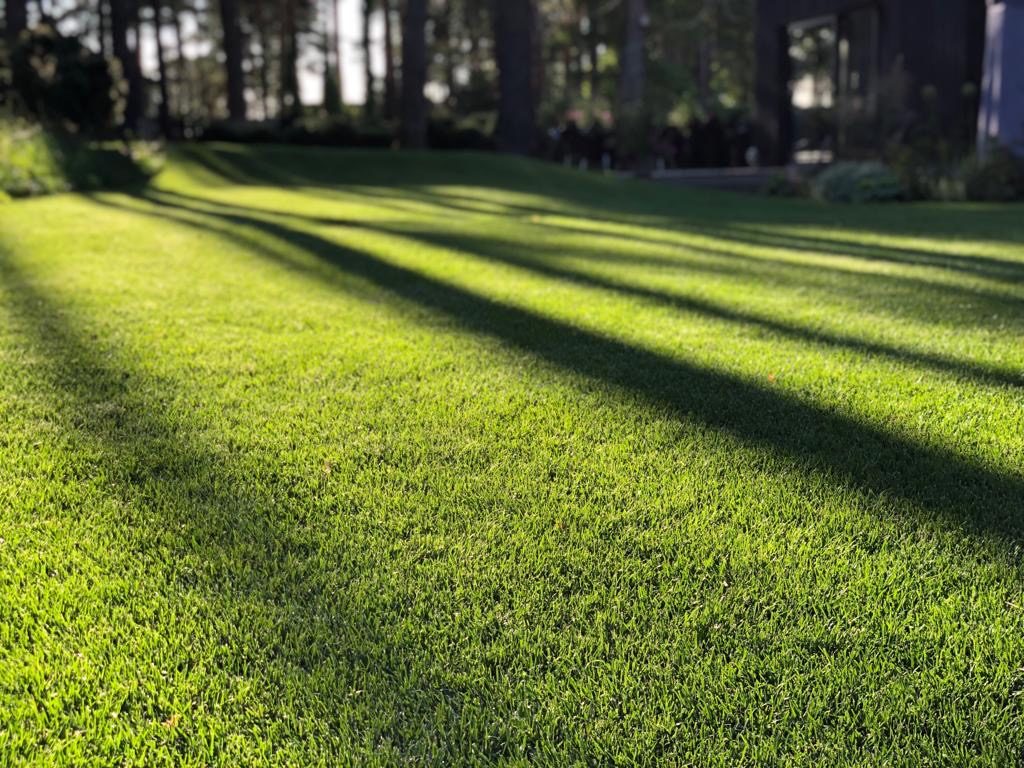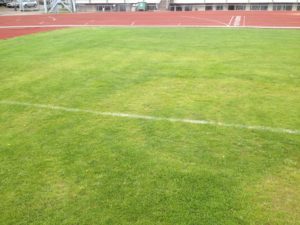
Fertilising your Lawn.
Why Lawn Fertilisation is important?
For a healthy lawn to thrive it needs nutrients. When you fertilize your lawn, these nutrients will help it to grow deeper, root itself in a healthy way. It will become greener, lusher and will be able to fight against any invasive weeds.
Most important about feeding your lawn:
- Spread the required amount according to the instructions and evenly.
- Better less than more.
- When applying fertiliser walk at the same speed over the whole area.
- Do not feed on a sunny, hot day.
- Water your lawn after the application of the fertiliser.
- Make sure to use all the protective equipment when handling the fertiliser (mask, glasses, gloves etc.).
- Remove any fertiliser from walkways, curbs, and paths.
- Measure the required amounts away from the lawn, to avoid spillage.
When to fertilise your lawn?
Lawn needs to be fed when it requires additional nutrients. The most important is Springtime. This enables the lawn to start the season off with strong, vigorous, and healthy growth.
As soon as the soil starts to warm up, the grass will start to grow, usually around mid-April or beginning of May. We recommend using compound top-dressing fertiliser containing higher amounts of Nitrogen and other micro elements, but Nitrogen is the most essential for this time of year. Nitrogen is required for leaf growth. The lawn will be able to produce strong and healthy growth, and it will be able to recover from any damage done during Winter months.
We recommend feeding the lawn during the middle of Summer with balanced slow-release fertiliser. Balanced fertilisers contain all the essential macro and micro elements. Three main nutrients in lawn feed are N-P-K, Nitrogen – Phosphorus- Potassium. So, during the summer months your lawn will require more of K, which is Potassium.
Weather conditions in Autumn will determine when to apply Autumn feed. In general, the last feed should be applied at the beginning of September or the middle of September at latest (if there is good maintenance practice in place). Last application of fertiliser should be considered very carefully and if not sure consult specialists. Autumn fertiliser should contain little or no Nitrogen, but it should have enough of Potassium!
The frequency of application of fertiliser depends on how the lawn is maintained. Try not to apply fertilisers during a very hot or sunny day, especially the ones containing Nitrogen. When you apply excess amounts of Nitrogen to lawn, the result is scorching – yellow or brown discoloration and root damage. The best time to apply any fertiliser is just before or during the rainfall – that means that all the essential nutrients will be washed down into the rootzone. If there is no rain forecasted, apply fertiliser in the evening and water it in, making sure there is no fertiliser left on the foliage.
How to fertilise your lawn?
Domestic lawns can be fertilised in two ways – spreading by hand or using a lawn spreader. It is important to apply the fertiliser accurately and evenly. Uneven application will create very patchy and uneven lawn – mix of darker and lighter or even yellow spots.
Applying fertiliser by hand wear gloves, walk backwards across the lawn as you throw the fertiliser as evenly as possible in a sweeping motion.
The application rate is approximately 25g/m2.
Correctly used lawn spreaders are the most efficient way to distribute fertiliser. Fertiliser will be applied evenly and quickly. When the shutoff plate is open the impeller broadcasts the fertiliser in a 180-degree arc and up to 8m (depending on module, size of granules and walking speed).
How much fertiliser to apply? There are great selection specific fertilisers in shops now. For example, ‘Spring Lawn feed’ or ‘Autumn Lawn feed’, which makes it easier to select the right product. But here are few more basic tips for selecting the most appropriate fertilisers for your lawn.
Use compound fertiliser (that contains as many microelements as possible) with an application rate of 15-25g per m2.
There are different types of fertilisers, depending on their usage, season, area of application, or components. When shopping for fertiliser, you will find three numbers printed on the label. These numbers represent three primary nutrients Nitrogen (N), Phosphate (P) and Potassium (K). So, a bag of 22:7:12 +2S will have 22% (22 g per 100g) Nitrogen, 7% (7g per 100g) Phosphate and 12% (12g per 100g) Potassium and this fertiliser contains Sulphur (S). The longer the list of ingredients the better, but make sure you check the main three components NPK. In Spring Nitrogen is more important, so choose one with high Nitrogen levels (anything containing NPK 24:6:12, NPK 18:9:9). Summer feeds will have less of Nitrogen (NPK 16:16:16 or NPK 20:10:10, Autumn feeds will have little or no Nitrogen (NPK 5:10:22 or NPK 0:5:12). There are many suppliers of fertilisers on the market, and they change from year to year!
These are just few guidelines, because it is not important how big is the number, but the proportion among the numbers and the time of year you are applying the fertiliser.
The description of primary nutrients.
Nitrogen (N) promotes growth, leaf colour, and plant development. The yellowing, pale green, slow development of typically green plants indicates a nitrogen deficiency. Spring and early Summer are the key seasons for adding Nitrogen, as the grass will be growing. As Autumn comes around, the amount of Nitrogen in the fertiliser should be decreased, it should be replaced by other important nutrients. During these months’ plants need to prepare themselves for Winter. Nitrogen is soluble, it evaporates quickly, and it is washed away fast, especially in sandy soil. So, therefore it is important to apply Nitrogen based fertilisers on overcast days, shortly before rain or water it in immediately after the application. Nitrogen is the most abundant chemical in the earth’s atmosphere, however vast majority is in a gas for and cannot be absorbed by plants. It is up to the gardener to add Nitrogen to the soil. There are number of different types of nitrogen feeds – slow-release ones will release their nutrients over few months, fast action – immediate effect.
Phosphorus (P) is essential macronutrient responsible for healthy root development, flowers, and fruit, so Phosphorus is needed for healthy root development in our lawns. Strong roots should be deeper than 15 cm. Roots absorb nutrients and water, therefore it is important to have healthy and strong lawn root system. Phosphorus is very important at an early stage of grass development. Therefore, higher Phosphorus fertilisers are recommended for shallow-rooted, immature turf grass and in early Spring. There is a simple saying in lawn care – no roots, no grass! Phosphorus deposits in the soil.
Potassium (K) helps maintain strong plant cells. It also helps with a development of sugars, ripening and overwintering. Potassium is common element, which is found in potassium chloride (often known as Potash). Potassium improves drought tolerance, cold hardiness, and disease resistance. The application of Potassium becomes important towards the end of growing season and during the Winter months. Just like Phosphorus, Potassium deposits and stores in the soil, so it is much easier to apply. Sports pitches will require an additional application of Potash, as they are more free draining (good pitches should be well drained) and contain very little organic matter.
Plants not only need all the essential macro elements, but they require certain amounts of trace elements or microelements. Key trace elements to consider include Magnesium, Calcium, Manganese, Sulphur, Iron, Zink, Boron and others.
Too few macronutrients and you’ll get poor growth and potential for disease, too many micronutrients and you’ll see a loss of colour and reduced growth. As you can see, it is important to have a good balance of macronutrients and trace elements in your lawn. The levels of PH in the soil are very important, if soil is too acidic plants are not able to absorb nutrients and water.
Most common mistakes when feeding lawns:
- Applying fertiliser on a hot, sunny day – may cause scorching and Nitrogen will not be as effective as it evaporates quickly.
- Measuring fertiliser on the lawn – spillages will cause scorching.
- Stripy and patchy lawn – uneven application by hand.
- Using inappropriate lawn care tools – stripy and patchy lawn.
- Uneven spread – stripy and patchy lawn.
- Good news is, that your lawn will bounce back in time!
If you happen to spill some fertiliser on the lawn, remove as much of it as possible while it’s still dry. Once all the excess fertilisers have been swept and disposed of, you’ll need to treat the area by flushing large amounts of water.
But what if you cannot get the lawn to thrive and grow, no matter how hard you try? You are looking after it (mowing, feeding, watering and so on). The first thing to do when the grass is not growing well or not growing at all is to do the soil test. Check for organic matter, Ph levels and nutrient deficiencies, especially Phosphorus and Potash. Only when you have those results you will be able to solve the issues. These tests can be carried out at the State Plant Protection Service in Agrochemistry department, you might have to consult a specialist to help understand the readings.



